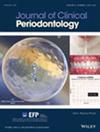Efficacy of Injectable Bone Fillers for Alveolar Ridge Preservation: A Histomorphometrical Analysis.
IF 5.8
1区 医学
Q1 DENTISTRY, ORAL SURGERY & MEDICINE
引用次数: 0
Abstract
AIM To assess the efficacy of injectable bone fillers for alveolar ridge preservation (ARP). MATERIALS AND METHODS The mandibular premolars (P2, P3, P4) were bilaterally assigned to ARP in a total of n = 9 beagle dogs. Each P was decapitated and hemisected under preservation of the mesial (i.e., devitalization and filling with calcium hydroxide) and removal of the distal root. The resulting 6 extraction sockets were randomly allocated to a total of four injectable test materials (i.e., bovine bone particles + porcine collagen, lyophilized materials reconstituted with either blood or saline [T1, T2, T4]; or ready-to-use wet material [T3]) and one control material (collagenated bovine bone mineral) (C) as well as one negative control group (N). Primary wound closure was ensured in all test and C groups. At 12 weeks, dissected blocks were prepared for histomorphometrical analyses. Buccal bone height (BBH) was defined as a primary outcome. Lingual bone height (LBH), buccal and lingual bone wall width (BBW and LBW 1, 3 and 5 mm infracrestally), surface area of bone and particles, fibrous tissues, and bone marrows were defined as secondary outcomes. Between-group comparisons were assessed using ANOVA and Mann-Whitney tests. RESULTS After 12 weeks, all groups were associated with similar BBH values (BBH: 14.1, 14.0, 13.7, 13.8, 14.3 and 114.2 mm in the T1, T2, T3, T4, C and N groups, respectively; p > 0.05 for all between-group comparisons). The BBW and LBW measurements were comparable among the groups. ARP sites showed a trend towards higher area measurements of bone and particle surfaces compared with the N group (11.5, 11.6, 13.1, 12.5, 9.1 mm2 in T1, T2, T3, T4, C and N groups, respectively). C, T1, T2, T3 and T4 particles were associated with a similar marked grade of osteoconduction and osteointegration within the former extraction socket area. CONCLUSIONS Within its limitations, the present study has pointed to the similar efficacy of injectable bone fillers for ARP compared with the particulated bone substitute and negative control.可注射骨填充物保存牙槽嵴的效果:组织形态学分析。
材料和方法对 n = 9 只猎犬的下颌前臼齿(P2、P3、P4)进行双侧 ARP 治疗。每颗前臼齿都被斩首,并在保留中根(即去骨并用氢氧化钙填充)和去除远根的情况下进行半切。所得的 6 个拔牙窝被随机分配到总共四种注射测试材料(即牛骨颗粒 + 猪胶原蛋白、用血液或生理盐水重组的冻干材料 [T1、T2、T4];或即用湿材料 [T3])和一种对照材料(胶原牛骨矿物质)(C)以及一种阴性对照组(N)中。所有试验组和 C 组都确保了原发性伤口闭合。12 周后,制备解剖块进行组织形态学分析。颊骨高度(BBH)被定义为主要结果。舌骨高度(LBH)、颊骨壁宽度和舌骨壁宽度(嵴下 1、3 和 5 mm)、骨和颗粒表面积、纤维组织和骨髓被定义为次要结果。结果12周后,所有组的BBH值相似(T1、T2、T3、T4、C和N组的BBH值分别为14.1、14.0、13.7、13.8、14.3和114.2毫米;所有组间比较的P>0.05)。各组的 BBW 和 LBW 测量值相当。与 N 组相比,ARP 位点的骨和颗粒表面的面积测量值呈上升趋势(T1、T2、T3、T4、C 和 N 组分别为 11.5、11.6、13.1、12.5 和 9.1 平方毫米)。C、T1、T2、T3 和 T4 颗粒与前拔牙窝区域内明显的骨传导和骨整合等级相似。
本文章由计算机程序翻译,如有差异,请以英文原文为准。
求助全文
约1分钟内获得全文
求助全文
来源期刊

Journal of Clinical Periodontology
医学-牙科与口腔外科
CiteScore
13.30
自引率
10.40%
发文量
175
审稿时长
3-8 weeks
期刊介绍:
Journal of Clinical Periodontology was founded by the British, Dutch, French, German, Scandinavian, and Swiss Societies of Periodontology.
The aim of the Journal of Clinical Periodontology is to provide the platform for exchange of scientific and clinical progress in the field of Periodontology and allied disciplines, and to do so at the highest possible level. The Journal also aims to facilitate the application of new scientific knowledge to the daily practice of the concerned disciplines and addresses both practicing clinicians and academics. The Journal is the official publication of the European Federation of Periodontology but wishes to retain its international scope.
The Journal publishes original contributions of high scientific merit in the fields of periodontology and implant dentistry. Its scope encompasses the physiology and pathology of the periodontium, the tissue integration of dental implants, the biology and the modulation of periodontal and alveolar bone healing and regeneration, diagnosis, epidemiology, prevention and therapy of periodontal disease, the clinical aspects of tooth replacement with dental implants, and the comprehensive rehabilitation of the periodontal patient. Review articles by experts on new developments in basic and applied periodontal science and associated dental disciplines, advances in periodontal or implant techniques and procedures, and case reports which illustrate important new information are also welcome.
 求助内容:
求助内容: 应助结果提醒方式:
应助结果提醒方式:


